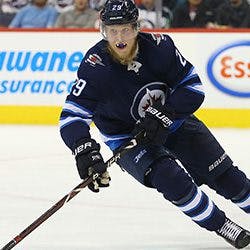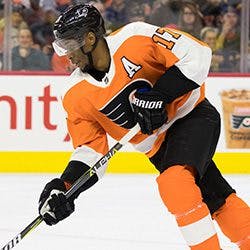Ranking Fantasy Hockey Right Wingers By Tiers (1-5)


Over the course of the next five weeks, we will be churning out a bunch of content to help you prepare for the 2019 fantasy season. Our Projections and Cheat Sheets will be out soon, as well as the classic posts like: Sleepers, Breakouts, Busts, and Rookies to Target.
These tier posts breakdown our positional rankings to help you better understand who you should be targeting and when you should be going after them. Here are our top right wingers for the 2018-19 season, starting with tiers 1-5.
Tier 1
Nikita Kucherov (TBL)
As far as right wingers are concerned, Kucherov proved last year to be in a league of his own. He followed up his 40 goal, 85-point campaign in 2016-17 by breaking the 100-point plateau for the first time in his career. Despite scoring nine fewer powerplay goals in 2017-18, Kucherov fell just one goal shy of his total two years ago, thanks to a jump in even strength goals from 23 to 31. He should see plenty of run alongside Steven Stamkos again this season, and the 31 scoring chances per 60 they averaged together in over 700 minutes of 5v5 ice time solidifies Kucherov as the number one option at right wing. Kucherov has a floor this season of around 80 points and is a real threat to break triple digits again.
Tier 2
Patrick Kane (CHI), Patrik Laine (WPG), David Pastrnak (BOS), Blake Wheeler (WPG)

Patrick Kane dropped below a point per game last season for the first time since 2011-12, in large part thanks to dips in his personal and on-ice shooting percentages. Slight regressions in those areas should be enough to help Kane get back in line with his career scoring rates. The dominance of Pastrnak and his linemates at even strength gives him as solid of a floor as any in this tier, though he’ll likely need to push for 300 shots this year (career high is currently 262) if he wants a realistic shot at 40 goals. Wheeler is one of the best playmakers in the game today, averaging 56 assists over his last three seasons. His inability to break 30 goals is the only thing holding him back from being a top-five fantasy player.
Tier 3
Vladimir Tarasenko (STL), Phil Kessel (PIT), Jakub Voracek (PHI), Mitch Marner (TOR), Mikko Rantanen (COL), Brock Boeser (VAN)

Phil Kessel exploded for 92 points last season, the result a lot of us expected when he first made the move to Pittsburgh in 2015-16. His point total was driven by a league-best 42 powerplay points, an impressive achievement to be sure but not one that should be considered sustainable. He should be closer to 70 points this season and, assuming his shooting percentage falls back in line with his career average, his Wheeler-esque goal-scoring rate keeps him out of our second tier of right wingers.
Like Kessel, Voracek tallied an abundance of powerplay helpers last season, propelling him to 65 assists and 85 points. He’ll need a lot to go his way to break 80 points again this year, and with a career high of just 23 goals, he doesn’t score enough to justify anything more than a late second-round pick. Playing alongside John Tavares for a full-season, assuming Mike Babcock is true to his word, should be more than enough to push Marner over 70 points, but he’ll need to start shooting the puck more (career high of 192) if he wants to avoid the same pitfalls of Voracek and Wheeler’s fantasy values.
While his skillset is certainly nothing to scoff at, Rantanen’s breakout 84-point season a year ago was in large part driven by his linemate, Nathan Mackinnon. There’s nothing wrong with that assuming head coach Jared Bednar plays the pair together again this season, but their absurd home and away splits from a year ago suggest there is regression coming for both of the Avalanche’s young stars. Boeser was on pace for 38 goals before injuries ravaged his stellar rookie campaign. Assuming a healthier 2018-19, The 21-year-old is a safer bet to hit 35 goals than any of the guys listed in the tiers below. More experience and ice time should help him build on an already impressive shot pace of 236 as a rookie. If he’s able to push for 300 shots, he could be a 40-goal threat this season.
Tier 4
Alexander Radulov (DAL), Joe Pavelski (SJS), Mikael Granlund (MIN), William Nylander (TOR), Mark Stone (OTT), Viktor Arvidsson (NSH)

After notching three straight seasons with at least 37 goals (2013-2016), Pavelski has failed to top 30 goals in back-to-back seasons. The Sharks’ captain has remained an elite playmaker, however, and has proven to be as durable as any player in the league. Incredibly, Pavelski has missed just one game since the beginning of the 2011-12 season. That’s 539 of a possible 540 regular season games played across seven seasons. He played well alongside Evander Kane, tallying 14 points in 17 games after Kane was acquired. The pair averaged a robust 43 scoring chances per 60 at 5v5 together, making them one of the more underrated tandems in the league heading into theseason.
Granlund, Stone, and Arvidsson are all similar in that they are unlikely to break 70 points, but their usage and roles on their respective teams should be enough to keep a 60 to 65-point season well within reach. Nylander’s role and ice time are much less defined in Toronto’s potent corps of forwards. Skating alongside Auston Matthews at 5v5 and with the man advantage should be enough to keep him above 60 points again this season, but don’t expect him to be anywhere near a point-per-game pace if he continues to see less than 17 minutes of ice time a night.
Tier 5
Jordan Eberle (NYI), Evgenii Dadonov (FLA), Cam Atkinson (CBJ), Corey Perry (ANA), Wayne Simmonds (PHI)

Atkinson and Perry are very similar in that their usage and ice time should be enough to keep their production at a viable level. Atkinson will hope for a healthier 2018-19 after missing 17 games with a foot injury last season. A better start and a more reasonable shooting percentage should be enough to help Perry flirt with 60 points this year.
Though he remains one of the more reliable goal-scoring threats in the league, Simmonds’ usage is due to take a hit with the Flyers’ acquisition of James van Riemsdyk. Given head coach Dave Hakstoll’s tendencies, it’s fair to assume that Travis Konecny will start the season alongside Claude Giroux and Sean Couturier on the top line, with Voracek and JVR accounting for the second-line winger slots. Unless Giroux is shifted back to centre at some point, Simmonds seems destined to spend the majority of the season carrying the Flyers’ third line. Given JVR’s proficiency with the man advantage, it’s likely that Simmonds gets bumped down to the second powerplay unit as well. Given all the doubts surrounding his usage, his raw ability to put the puck in the net (28.8 goals per season dating back to 2013-14) is the only thing keeping Simmonds from sliding further down our list.